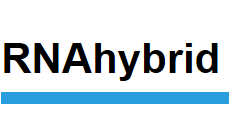Status:
Platform:
Species:
MicroRNAs (miRNAs) are short RNAs that post-transcriptionally regulate the expression of target genes by binding to the target mRNAs. Although a large number of animal miRNAs has been defined, only a few targets are known. In contrast to plant miRNAs, which usually bind nearly perfectly to their targets, animal miRNAs bind less tightly, with a few nucleotides being unbound, thus producing more complex secondary structures of miRNA/target duplexes. Here, we present a program, RNA-hybrid, that predicts multiple potential binding sites of miRNAs in large target RNAs. In general, the program finds the energetically most favorable hybridization sites of a small RNA in a large RNA. Intramolecular hybridizations, that is, base pairings between target nucleotides or between miRNA nucleotides are not allowed. For large targets, the time complexity of the algorithm is linear in the target length, allowing many long targets to be searched in a short time. Statistical significance of predicted targets is assessed with an extreme value statistics of length normalized minimum free energies, a Poisson approximation of multiple binding sites, and the calculation of effective numbers of orthologous targets in comparative studies of multiple organisms. We applied our method to the prediction of Drosophila miRNA targets in 3'UTRs and coding sequence. RNAhybrid, with its accompanying programs RNAcalibrate and RNAeffective, is available for download and as a Web tool on the Bielefeld Bioinformatics Server (http://bibiserv.techfak.uni-bielefeld.de/rnahybrid/).[1]
In the elucidation of the microRNA regulatory network, knowledge of potential targets is of highest importance. Among existing target prediction methods, RNAhybrid [M. Rehmsmeier, P. Steffen, M. Hchsmann and R. Giegerich (2004) RNA, 10, 1507-1517] is unique in offering a flexible online prediction. Recently, some useful features have been added, among these the possibility to disallow G:U base pairs in the seed region, and a seed-match speed-up, which accelerates the program by a factor of 8. In addition, the program can now be used as a webservice for remote calls from user-implemented programs. We demonstrate RNAhybrid's flexibility with the prediction of a non-canonical target site for Caenorhabditis elegans miR-241 in the 3'-untranslated region of lin-39. RNAhybrid is available at http://bibiserv.techfak.uni-bielefeld.de/rnahybrid.[2]
References
- Fast and effective prediction of microRNA/target duplexes.,
, RNA, 2004 Oct, Volume 10, Issue 10, p.1507-17, (2004)
- RNAhybrid: microRNA target prediction easy, fast and flexible.,
, Nucleic Acids Res, 2006 Jul 1, Volume 34, Issue Web Server issue, p.W451-4, (2006)







